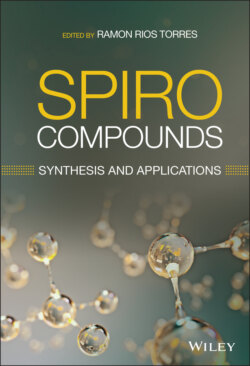Читать книгу Spiro Compounds - Группа авторов - Страница 15
2.3 Property Optimization in Bioactive Compounds
ОглавлениеSpirocyclic structures displaying a wide range of biological activities have been reported [32, 33] (Figure 2.4). For example, the representative SAR405838 (16) belongs to a family of potent spirooxindole derivatives potently inhibiting MDM2 [34, 35]. MDM2 inhibition has attracted high attention for the development of anticancer therapeutics acting via reactivation of the tumor suppressor protein p53. The oxindole ring mimics the Trp23 side chain of p53, and makes key contacts with Leu54 backbone carbonyl in MDM2 via its NH group (protein data bank codes 1YCR and 3LBL). At the same time, the spirooxindole motif provides conformational restriction to the scaffold, “locking” the molecule in the optimal conformation for binding MDM2 with sub‐nanomolar affinity. 16 was recently examined in phase 1 clinical trials in patients with advanced solid tumors [36, 37]. Conformational restriction has also previously been employed by Schafmeister and coworkers for the development of covalently constrained helix mimetics targeting MDM2 [38]. Solid‐phase synthesis of the peptidic backbone followed by formation of the diketopiperazine linkages led to the rigid spiro‐oligomer 17 (K d = 400 nM) [38–40], whose hydrophobic R‐groups project in a (i, i+4, i+8) fashion. Those mimic the side chains of residues Phe19, Trp23, and Leu26 of p53 and make key contacts at the MDM2 surface. 17 displayed cell permeability and activity, and induced p53 upregulation in Huh7 cells. It is worth noting that the backbone of these constrained helix mimetics have very low conformational freedom, making their de novo design challenging and as a result, only few examples have been reported. Another good example of spirocycle functionalized compound is the Calcitonin Gene‐Related Peptide (CGRP) Receptor antagonist 18, which has progressed to Phase 3 clinical trials and is expected to reach the market for the treatment of migraine in the early 2020s [41]. Introduction of the spirocycle in this molecule led to enhanced metabolic stability compared with non‐spirocyclic analogues, for example, bearing labile and oxidation prone dihydroquinazolinone units [42]. Lead molecule 19 was discovered as part of a lead optimization effort at AstraZeneca aimed at improving the properties of molecules targeting the central nervous system (CNS), more precisely the melanin‐concentrating hormone receptor 1 (MCHr1), a target protein for the treatment of obesity and its downstream effects [43]. An important focus has been to identify a chemical series with attractive physicochemical properties, including reduced interaction with the ether‐a‐go‐go‐related gene (hERG) channel [44] while retaining fine‐tuned lipophilicity profiles and sufficient CNS exposure [45]. The appended spirocyclic moiety provided improved physicochemical properties required for CNS exposure while lowering off‐target interactions toward hERG, compared with morpholine and open ring analogues. Another early example is the triaryl bis‐sulfone derivative 20, which was identified by Merck as a potent type 2 canabinoid receptor (CB2) antagonist [46]. Modulation of CB2 has been proposed as a strategy for the development of immunomodulators. Replacement of the central phenyl ring of 20 with a spirocyclopropyl piperidine, saturated unit led to sulphonamide analogue 21. The latter displayed a similar binding mode, potency, and selectivity profile against CB2 as parent 20. Reduction in the number of aromatic rings is known to affect the physicochemical properties, hence developability of leads [31, 47]. Pleasingly, 21 showed reduced off‐target effects as exemplified by a c. 10‐fold reduction in affinity against the rat calcium channel and the cytochrome P450 2C9, while also presenting a beneficial clogP drop from 2.81 to 1.48.
Figure 2.4 Examples of lead optimization employing spirocycles.
Sources: Based on Zheng and Tice [32]; Zheng et al. [33].
